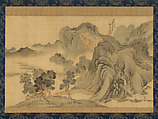Landscape in Light Colors
Yosa Buson Japanese
Not on view
This landscape encapsulates Yosa Buson’s engagement with Chinese styles. A solitary, red-clad figure sits in a cottage at lower left, looking toward distant mountains shrouded in a soft mist that hovers over the water. The use of mist to create an ambiguous, atmospheric effect, offering a transition from the foreground to the background, is often seen in handscrolls by painters of the Wu school, who flourished during the Ming dynasty (1368–1644) in Suzhou, China.
Buson established himself as a professional poet and painter in Kyoto, where he was able to access and copy an array of Chinese paintings, allowing him to develop his own refined synthesis of poetic imagery and artistic expression.
This image cannot be enlarged, viewed at full screen, or downloaded.
This artwork is meant to be viewed from right to left. Scroll left to view more.



